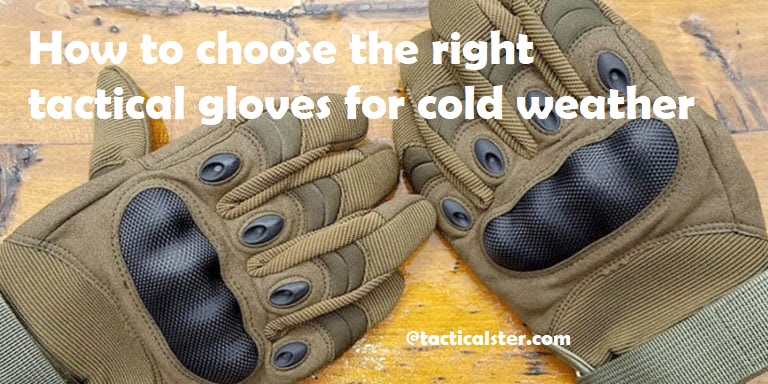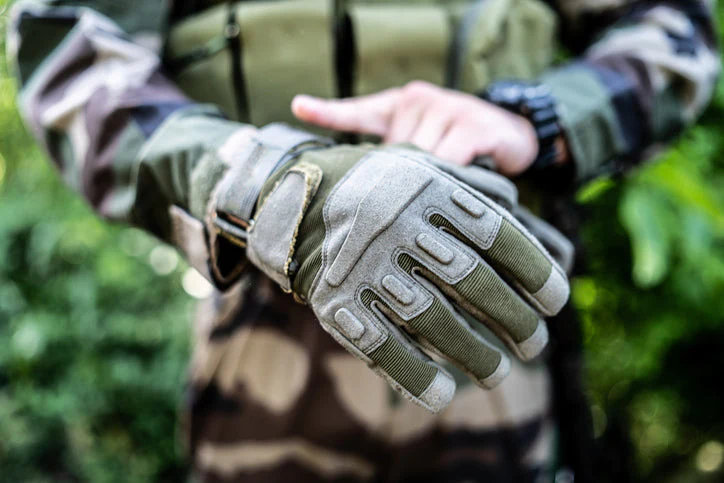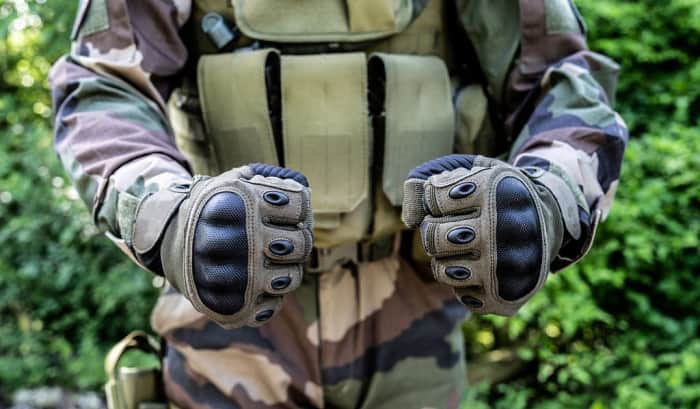You need the right tactical gloves to keep your hands warm and protected in cold weather. However, the sheer number of tactical gloves available can make selecting one difficult and confusing.
In this guide, we’ll show you how to make an informed decision on the best tactical gloves for cold weather.
Introduction
Tactical gloves are a staple item in any cold weather arsenal. They provide important protection against the elements, helping to keep hands warm and dry while also providing superior grip. However, choosing the right pair of tactical gloves is not as simple as it might seem. Different glove materials, construction techniques and features may be better suited for particular conditions and activities, so it pays to do your research before buying a pair – otherwise you may end up with inadequate or even dangerous protection in cold weather.
This guide will help you choose the best tactical gloves for your needs by discussing the different materials and functional aspects that go into making quality cold weather gloves. We discuss how to determine fit and why breathability is so important when selecting job-specific gloves, then review 10 distinct models from some of the most respected glove companies on the market today. Each pair of gloves is accompanied with details about their construction and other specifications, allowing you to compare and contrast between different models effectively. So if you’re ready to invest in some quality protection during your next cold weather mission or activity, read on!
Material Selection
When selecting tactical gloves for cold weather, the material should be chosen carefully to ensure you have the best protection for your needs. Materials used in these types of gloves vary widely, from wool and leather to synthetic fabrics and even metal plating. Each will provide an element of insulation in a rugged environment while also allowing flexibility when engaging with tactile objects.
Wool is a popular choice for tactical gloves due to its natural insulation properties, breathability and low cost. It’s important to choose a wool blend that offers the best mix of comfort and protection — thicker varieties may provide more insulation but can be cumbersome when working with precision tools or small items.
Leather is another common material used in tactical gloves as it provides greater levels of strength and durability in comparison to wool fabrics. It also has natural insulating properties due to being thicker than other materials such as cotton or nylon; however it can be significantly more expensive than some other options available.
Synthetic fabrics such as nylon or polyester can offer a great balance between flexibility and insulation depending on the individual fabric mix and thickness chosen. As these materials allow for better ventilation than leather, they may prove more comfortable for longer periods of wear — however bear in mind that approaches used in manufacturing synthetic fabrics often result in reduced levels of durability compared to wool or leather equivalents.
Finally, certain glove models feature metal plates on the palms or backhand areas – providing additional protection against abrasions as well as offering better heat dissipation during use – however this approach tends to add extra weight which must be considered if agility is an important requirement.
Leather Gloves
Leather gloves are known for their superior warmth and protection in cold conditions, making them a popular choice among adventurers who plan to brave the outdoors during colder months. To ensure that your leather gloves are up to the task, it is important to understand the different varieties of leather and their unique features.
The classic type of leather gloves is made from cowhide leather, which is ideal for wearing through rigorous activities such as hunting and camping in cold conditions. This type of hide has a thick layer plated with enough waxy fat lanolin oil to keep your hands warm and make sure you have a secure grip on objects even if it’s windy or raining. Sheepskin is softer-textured but still retains a protective barrier from moisture, so you won’t lose any dexterity when working with tools or fastening buttons in the cold weather. Waterproof synthetic materials like neoprene can also provide additional protection while maintaining the classic appearance of full-grain cowhide or sheepskin gloves.
The fit and feel of your gloves will be just as important as their construction quality; verify how many layers of insulation they provide before purchasing and make sure they maintain flexibility when worn over multiple layers of clothing. Silicone sublimation prints on some pairs can also increase grip traction when moving quickly in icy areas or climbing rocks on rough terrain. Lastly, be sure to check which parts are reinforced; these areas should typically include fingers tips and palms which subject to more wear during outdoor tasks that require a secure grasp on objects in the elements. With the right combination of features you should be able to find quality tactical gloves that keep your hands warm wherever you encounter cold weather!
Synthetic Gloves
Synthetic gloves are a popular choice for cold weather conditions because they are typically lightweight and breathable while still providing excellent warmth and protection. Affordable synthetic gloves will generally include some combination of polyester, lycra, and spandex that provide increased flexibility. Waterproof membranes such as multiple layers of polytetrafluoroethylene (PTFE) or polyurethane (PU) can also be included for extra protection from the elements. Synthetic gloves are great for moderate to cold temperatures, but may not be optimal if venturing into extreme cold environment — you’ll want to opt for a heavier duty leather option in such cases.
Popular synthetic tactical glove choices include:
- 5.11 Tactical HardTime Gloves
- Blackhawk S.O.L.A.G. Special Ops Leather Touchscreen Gloves
- Tatam Scavenger Pro Soft Glove
Hybrid Gloves
Hybrid gloves, sometimes referred to as 3-in-1 gloves, combine the properties of multiple styles for an all-in-one form of glove. Ideal for active wear and hiking, hybrid gloves usually provide an outer shell made of stain and water resistant materials for overall insulation along with several layers in the palm and on the back of the hand. The inner liner is a thin but insulated material that adds an extra layer of warmth directly against your hands. The combination provides both warmth, ventilation, grip and protection when hiking or facing cold air under outdoor activities.
Hybrid gloves are generally easier to put on than mittens since they don’t require full hands entry but still keep your fingers separate. They are versatile enough to be used in more extreme climates when paired with additional insulated liner gloves or be used alone as a light glove under mild conditions. It is important to choose hybrid gloves that are waterproof while also providing adequate breathability depending on your needs since they come in many styles and variations suited to different temperatures and weather conditions.
III. Insulation
Insulation is essential for cold weather gear to keep your body warm and functioning, and the best tactical gloves are no different. Insulation is measured in thermal resistance (R-Value), how well a material resists heat flow. It is important to purchase gloves that have the right insulation for the temperature conditions in which you intend to use them.
Temperature-wise, when it comes to tactical gloves, many outdoor enthusiasts will layer up with gloves that are thinner and extremely flexible for higher-intensity activities such as winter mountain biking or snowshoeing. Thicker insulated gloves with leather palms can provide superior warmth for more leisurely activities like walking around town on a cold winter evening or skiing.
Modern glove fabrics often rely on synthetic insulating materials like PrimaLoft®, Thinsulate®, and Polartec® Alpha® — which offer varying levels of warmth depending on the fabric’s R-value rating. For example, PrimaLoft Silver 200g Insulation offers an R-value of 1.3 meaning it is designed for very cold temperatures (0° F—15° F/-18° C— -9° C) while PrimaLoft Gold Insulation 250g/m² provides an R-value of 2.2 ideal for colder temperatures(-10° F— 5 ° F/-23 ° C— -15 ° C). The amount and type of insulation provided by gloves primarily determines its warmth retention capabilities, but factors such as fit, breathability, and water repellency are worth considering as well.
Types of Insulation
Tactical gloves are designed to provide protection from extreme temperatures and can be useful for a range of cold weather activities. In order for gloves to provide maximum insulation, they must utilize different types of insulating materials. Depending on your needs, there are several types of insulation available in tactical gloves:
- Synthetic Insulation – Synthetic insulation is often found in tactical gloves designed to provide a consistent warm temperature while wicking away moisture when the wearer’s hands become wet. It is lightweight, easy to pack and is resistant to light and air damage.
- Down Insulation – Down insulation provides superior warmth by trapping air in its feathers which helps keep the heat close to the skin. This type of insulation is also lightweight but tends to lose its warmth if it gets wet or compressed due to packing over long periods without use.
- Thinsulate Insulation – Thinsulate insulation is another type of synthetic insulation that is highly breathable and resists water absorption making it great for use in cold weather conditions like skiing, mountaineering and winter camping trips where riders have limited movement with their hands due snow gear like ski boots and heavy clothing layers keeping their body temperatures low outside of glove heated areas like pockets or cuffs.
- Primaloft Insulation – Primaloft insulation is considered one of the best insulating materials available as it traps heat even when exposed to wet conditions or high levels of humidity; perfect for areas with extreme cold weather climates as well as activities that involve an intensive amount of movement such as ice fishing rowing, biking or running where sweat may be generated quickly causing the internal temperature of their hands drop drastically if not fully insulated proper protective gear worn external covering their body parts receiving elevated levels wind pressure thus causing severe chill making activity difficult without proper accommodation.
Considerations when selecting insulation
When selecting insulation for your tactical gloves, there are a few things to consider. Insulation is designed to keep you warm, but too much can make the gloves bulky, and in extreme temperatures, it can be difficult to use. High-quality insulation should provide a balance of warmth and comfort without compromising movement.
Gore Tex gloves are made with membrane technology that provides moisture and wind protection while ensuring breathability. Insulated or liner gloves offer less protection at warmer temperatures, but may be necessary when venturing into extreme cold weather conditions. Insulated liners add an additional layer of insulation beneath the shell of your glove for increased warmth.
Finally, make sure the fit of your tactical gloves is snug enough for optimal performance — loose-fitting gloves tend to lose their heat faster as cold air enters through gaps in the construction. Consider investing in several different pairs so that you always have an appropriate choice when choosing gear in different weather conditions.
Water Resistance
When you’re spending time outdoors in cold weather, it’s important to choose tactical gloves that are designed to keep your hands dry and comfortable. Look for gloves with a waterproof coating to ensure that no water or snow is able to penetrate the fabric. You should also consider materials like neoprene and nylon, which provide excellent water resistance.
The material itself should be breathable, so you don’t end up with sweaty hands during the course of a day spent outdoors. Additionally, look for adjustable cuffs with an extra seal around the wrists or at least some long gauntlets that will prevent water from running down your arm and into the gloves. Finally, be sure to check for seams; any high-quality pair of tactical gloves will have sealed seams in order to minimize the risk of water infiltration.
Importance of Water Resistance
When it comes to choosing the right pair of tactical gloves for cold weather, water resistance is an important factor to consider. Waterproof gloves can help keep your hands dry when you’re out in the cold and wet.
Waterproof tactical gloves are designed with sealed seams, durable surfaces and overlays which help block water from entering their insulation layers and penetrating your hands. The materials used in waterproof tactical gloves usually include neoprene, leather, nylon and polyester. These materials work together to seal out moisture while also providing warmth and a comfortable fit.
Additionally, some tactical gloves feature a special “permeable membrane” which allows moisture vapors to escape while still blocking rain and snow from entering the body of the glove. This helps keep your hands warm while preventing any uncomfortable clamminess caused by sweat buildup inside the glove.
Investing in waterproof gloves will ensure your hands stay warm and dry even when faced with harsh weather conditions.
Types of Water-resistant Materials
Next, you will want to consider what type of tactical gloves are made from water-resistant materials that can keep your hands warm and dry. Many styles will include a waterproof membrane such as Gore-Tex, which is highly breathable and provides an additional layer of protection between your skin and the elements.
Other materials to look for include breathable nylon shells with a Durable Water Repellent (DWR) finish, as well as seamless palm construction with zoned areas of cushioning, insulation and flexibility. Additionally, some tactical gloves offer advanced coatings like windproof/breathable laminates or lamination of various materials to create a superior level of weather protection.
Choose a pair with removable liners if you live in a climate where temperatures can vary considerably. In this way, you can adjust the levels of warmth without having to invest in multiple pairs.
Grip and Dexterity
Grip and dexterity are important factors to consider when choosing tactical gloves because a glove should provide you with enough grip to handle weapons and tools while still providing enough dexterity to complete complex tasks. Gloves should also be padded at the fingertips and other vulnerable areas to keep your hand safe.
Pay attention to the finger material. Smooth materials like leather will wear out more quickly than stitched materials such as textile or neoprene, but they provide better grip and less bulk. Look for double-stitched joints with reinforced gussets at the fingertips for more support and added durability. Gripping power can also be improved by adding a velcro strap wrap around the wrist or elastic closures over the knuckle area, allowing you to cinch down gloves when needed.
Make sure you try on gloves before purchasing so that you can gauge fit and make sure they don’t restrict your movement too much.
Fit and Comfort
When selecting tactical gloves for cold weather, it is important that the fit of the gloves is correct. Gloves should fit snugly without feeling too tight and they should not be too loose as this can cause the warmth of the glove to be lost. It is also important that there is enough flexibility in the fingers to allow full movement. If a glove feels difficult to move in, it could hamper performance or reduce dexterity if a task needs completing.
Tactical gloves are also designed according to cut and pre-set styles – usually with either a pull-on or clip/buckle closure depending on their application – and must provide prudent protection against water, wind, cold and any other external element you may encounter while completing your task.
In addition to the fit of the gloves, comfort should also be taken into consideration when making a purchase decision as this will enable you to use them for longer periods of time, even under freezing conditions. Insulated liners have been specifically engineered for cold weather performance by incorporating fabrics such as fleece for extra warmth and comfort, or highly technical membrane materials such as GORE® WINDSTOPPER®, which offer excellent windproofing protection against cold winds and rain whilst remaining breathable.
VII. Conclusion
In conclusion, the right tactical gloves for cold weather can mean the difference between a successful outing and an uncomfortable one. Weather conditions play a large role in selecting the right gloves, and certain environmental concerns must be taken into consideration when making a purchase. It’s important to consider your personal use, such as if you will be using the gloves for hunting or backpacking activities. Considerations can also be made concerning material type, as certain types of insulation offer more protection than others.
Keep these tips in mind and you’re sure to find the best cold weather tactical gloves for your needs!
See Also-
- Best Tactical Chest Rig
- Best Tactical Boots
- Best Tactical Belts
- Best Tactical Backpacks
- Best Lightweight Tactical Boots

